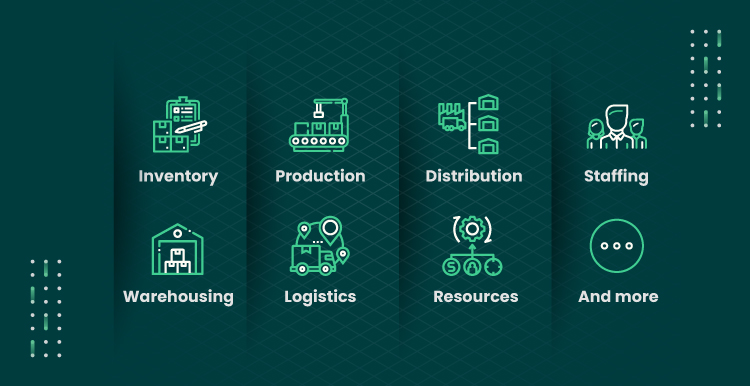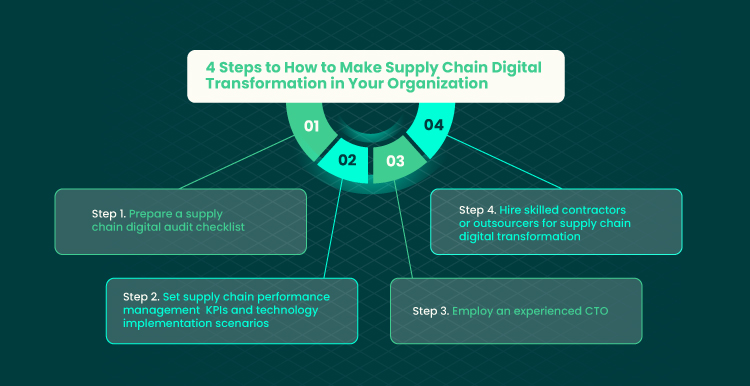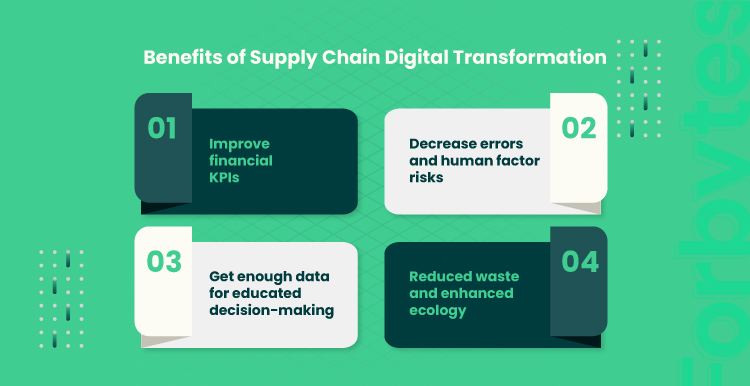Supply chains are the foundation of the modern world’s economy. Basically, the supply chain represents the movement of goods, materials, crops, and/or parts from suppliers throughout all levels of the production process, including transportation, warehousing, and distribution of ready products on retail markets.
Modern supply chains usually involve a great number of intermediary links, overseas shipments, complicated international logistics, and cross-border collaboration between distantly placed partners and suppliers, not to mention that this comes with many cultural, time zone, and language barriers.
In this article, we’ll discuss everything there is to know about supply chain digital transformation and the ways of improving supply chain efficiency. Before we delve into specifics, let’s consider what pesters modern supply chains the most.
Supply Chain Issues to Be Resolved Through Digital Transformation
Traditional supply chains are prone to numerous errors and potential disruptions that cause multi-billion-dollar losses from an annual perspective. These chains can get easily disorganized because they rely on many complicated factors and can hardly sustain the following supply chain issues:
Sudden supply chain disruptions
An abundance of unforeseen events can cause potential supply chain disruptions, including political, economic, and climate changes. There is even room for global shocks and crises emerging out of the blue, like the COVID-19 pandemic or Russia’s war against Ukraine, which unveil their monstrous potential to block or ruin thousands of vital and well-tuned supply chains for good.
Inventory shortages
This type of issue can emerge out of bad economic planning, poorly predicted demand peaks, inadequate production, cascade problems coming from previous supply chain links, local business problems like supplier bankruptcy, or an emergency that destroys supply stocks (fire, flood, earthquake, you name it.)
Weak connections between supply chain links
Different supply chain participants often exchange data inconsistently, maintain poor communications, and show a lack of coordination, which generally decreases their ability to adjust inventories and react to possible shortages, emergencies, and disruptions in a timely manner.
How to improve supply chain efficiency and reliability? Modern technology strategists give us a clear answer: traditional supply chains must undergo complex tech upgrading called a digital transformation, which is intended to make supply chains better controlled, technology-driven, smarter, more flexible, eco-friendlier, and more transparent.
Sounds good? Let’s delve into detail.
What Is Digital Transformation in the Supply Chains?
Supply chain digital transformation requires massive, intense, and all-encompassing implementation of automation and electronic data exchange methods in different stages of supply chains. This revolutionary undertaking covers the following supply chain components (but is not limited to them):

supply chain digital transformation
According to the Industry 4.0 concept explained by IBM, supply chain digital transformation includes the adoption of the following technologies throughout their operations and facilities:
- The Internet of Things (IoT);
- Cloud-based computing;
- Big Data Analytics;
- AI and ML (Machine Learning);
- Blockchain;
- Custom software development.
Different supply chains can have different requirements for digitalization depending on their industry, current levels of digitalization, supply chain lengths, and other important factors. All of them affect the complexity and costs of the digital solution required: only a skilled engineer can tell you the exact mix and proportion of different technologies you will need for your supply chain.
But is the game worth the candle? A consistent digital transformation process of supply chains is definitely a technological breakthrough and a wise choice for companies that want to sustain market turbulence and online retail challenges. Here’s why.
The Benefits and Reasons for Supply Chain Digital Transformation
The advantages of digital transformation for supply chains are enormous and worth serious investment. Let’s consider some of them.
Improve financial KPIs
Automated and transparent tracking of inventory flows, along with streamlined logistics, mapping, and process forecasting, allows for cutting operational costs.
In other words, if a supply chain manager can foresee certain bottlenecks or issues in the way of moving supplies, he/she can consider redirecting supply flows to different routes or optimizing them in any other suitable way. This can be executed with the help of interactive maps, IoT trackers, and other IT solutions representing a flow of inventories in real time.
Decrease errors and human factor risks
Adoption of IoT-controlled solutions for technological inspections of products and inventories in warehousing areas and industrial facilities can help save lots of time and money in comparison to traditional methods of manual assessment.
For example, quality control specialists can use a smartphone client app tethered to its server software in the cloud in order to monitor processes and check supplies remotely. ML-powered algorithms can spot even the slightest defects and report on them before quality issues worsen in the later stages of the process.
Get enough data for educated decision-making
Digital transformation of supply chains, if done correctly, can ensure a massive inflow of business data to be analyzed and used for acquiring more valuable insights for supply chain optimization, including trends, patterns, mathematical prediction, and more.
Besides data collected for long-term analytical goals, short-term operational decision-making and planning also require data captured from different checkpoints in a digitalized supply chain. Software platforms powered by AI models can help supply chain managers and business analysts make conclusions, shape their strategies, and plan scenarios for different situations, including sudden supply shortages or disruptions.
This can also lead to better coordination between different branches and segments of supply chains, e.g., account management, warehouse management, customer experience, sales and delivery, business development departments, and so on.
Reduced waste and enhanced ecology
Production and transportation processes empowered by digital eyes and brains can help you achieve tremendous results in decreasing inefficiencies and environmental damage. This can be the result of a streamlined approach to manufacturing combined with a strategy of opting for eco-friendly suppliers, meaning their adherence to sustainability.
The Signs of Efficient Digital Transformation in Supply Chain: How to Know It Is Finally Transformed
How can you understand that a sufficient digital transformation has been achieved in your supply chain? Look for the following features and indicators showing that your supply chain is on the right track of digital transformation.
Elastic logistics
When the supply chain is supported by smart algorithms capable of supply chain forecasting based on dynamically tracked environmental factors, it acquires so-called logistical elasticity – the ability to scale up/down supply chain capabilities and adjust infrastructure according to demand expectations and situation forecasting. The major technologies behind elastic logistics are big data analytics and increased automation of operations.
Total operational transparency and visibility
Thanks to modern logistics providers, the procurement process, freight, and shipment processes are easily managed with the help of specific dashboards and professional-grade software products. You can precisely track each piece of supply being transported by vessels, trains, and delivery trucks — thanks to GPS and other satellite geo-tracking technologies.
There is a lot of industrial automation, like container sensors and IoT-driven warehousing equipment, that helps to track all supply movements, manage inventory positioning inside premises, geolocate all hubs, obstacles, and points on the way of supplies. Moreover, supply chain managers can achieve optimized routing and storage protocols with the help of logistics software packages for industrial navigation and warehouse space planning.
Traceability and veracity of supply movements
Thanks to shared ledger technology like blockchain, it’s possible to make all movements of goods and supplies in the supply chain highly trustworthy, traceable, and consistent. With the help of a blockchain platform integrated with supply chain processes, supply chain participants can cooperatively confirm and record:
- Operation dates and timestamps;
- Inventory prices and other conditions;
- Geolocation details;
- Quality compliance;
- Certifications;
- Other essential inventory information.
Since the data in the blockchain cannot be altered, this tech solution helps avoid issues with the counterfeit and gray markets.
Personnel are empowered to do more in less time
If employees involved in supply chain management benefit from connected smart devices and sophisticated applications, they can perform their tasks faster and with fewer errors. For example, VR or AR (augmented reality) solutions can help warehouse workers efficiently navigate through large storage facilities to locate, find, check, verify, and process required items, packages, and inventories.
With the help of VR/AR apps or other connected solutions, these tasks can be executed more swiftly than in traditional supply chains. With the help of VR headsets or cheaper smart devices powered by custom augmented reality software, employees involved in supply chains can get:
- Hints that facilitate their ongoing tasks;
- Optimal storage routes to find certain positions in the shortest possible time;
- Warehouse navigation and maintenance information;
- Personalized tasks and instructions, and other helpful data;
- Less paperwork, thanks to scanners and automated warehouse fulfillment that updates all relevant records in ERP systems.
Highly manageable and collaborative supply orchestra
With the proper implementation of innovative supply chain management, it’s easier to avoid stockouts and delays, which means saving considerable resources. If a supply chain adheres to just-enough and just-in-time delivery stock strategies, it is always at risk of sudden distractions if a supplier fails to satisfy unexpectedly spiking demand. With a supply chain where ERP systems of all key participants are connected and synchronized, it’s much easier to harmonize stocks and production capacities to avoid shortages or overstocks.
How to Make Supply Chain Digital Transformation in Your Organization: Step-by-step Plan
Digitalization is a complex process that covers several major areas of activity. This project can be executed by specialized supply chain solution companies or in-house company specialists. Of course, it’s recommended that you resort to the help of supply chain digitalization professionals who know all the ins and outs of this process. Let’s see what has to be done to improve supply chain efficiency.

supply chain digital transformation
Step 1. Supply chain digital audit checklist
Make sure to hire a reliable tech partner or use your internal IT department to audit the current state of affairs in your supply chain. Answer the following questions:
- Do your employees use smart devices and software solutions to automate and facilitate their tasks?
- Is there anything to be improved or updated according to the best practices?
- Are there any technology gaps in business processes?
- Are there any better alternatives to the software products currently being used?
- Do you use ERP and other inventory management solutions?
- Do you use AI, ML, VR/AR, and/or blockchain platforms?
- Do you have synchronization of records regarding stocks and other collaborative processes with your suppliers and partners?
- Do you use supply prediction tactics and other smart methods in your practice?
- What are your current investments in digitalization?
- Is your available IT infrastructure well-maintained and kept in good health?
- Do you have IoT-powered systems used in freight, warehousing, and production operations? Are there ways to improve them?
Step 2. Set supply chain performance management KPIs and technology implementation scenarios
Supply chain performance management should provide a complex of parameters to be improved with the help of supply chain digitalization.
- Identify the KPIs that are expected to be improved through digitalization: freight bill accuracy, inventory turnover rate, warehousing costs, GMROI, delivery time, inventory-to-sales ratio, inventory velocity, and more.
- Draw a scenario of how each of the demanded metrics can be improved with the help of software and device solutions.
- Create an architecture of technology solutions intended to improve the given fields and KPIs in your supply chain.
- Consider saving time and money by incorporating ready-made solutions from third-party technology vendors, including Big Data platforms, industrial automation systems, and more.
Step 3. Employ an experienced CTO
Find a person who is experienced and skilled in relevant tech matters, a CTO (chief technology officer) who has worked with industrial automation and supply chains. They can help you deploy a team of technological partners for carrying out tech transformation, including:
- Create tech specifications for your digital supply chain transformation.
- Find tech partners and software development vendors that can help you with your supply chain digitalization project.
- Deal with contractors and partners; communicate your tech requirements and control execution of project tasks.
- Report to you on the implementation of digital transformation in the supply chain.
Step 4. Hire skilled contractors or outsourcers for supply chain digital transformation
- Use Google or professional directories like GoodFirms and Clutch to find promising vendors.
- Study their case studies and customer reviews: Have they had a successful experience with digital transformation in supply chains?
- Engage your CTO to negotiate with them and find out if they can help.
- Can one vendor fulfill most of your technological demands?
- Make sure they can work in a format convenient and suitable to the scope of your project and the collaboration model you want (dedicated development team, staff augmentation, and so on.)
Summary
Many companies working in the supply chain business demand custom automation and digitalization solutions that best fit their specific needs. A digital transformation is no longer an option but a necessity and a vital competitive advantage. Thanks to the benefits brought by digital transformation to supply chains, companies can quickly yield much more on their investments and keep working with considerably improved efficiency and enhanced financial metrics for a brighter future.
In supply chains, there exists no one-size-fits-all solution, but it’s highly advisable that a professional engineer help you with defining a specific tech configuration, including custom software, IoT, AI, and more. Do you need help with the digital transformation of a supply chain in your company? Contact us and we’ll gladly help you out.

Our Engineers
Can Help
Are you ready to discover all benefits of running a business in the digital era?

Our Engineers
Can Help
Are you ready to discover all benefits of running a business in the digital era?








